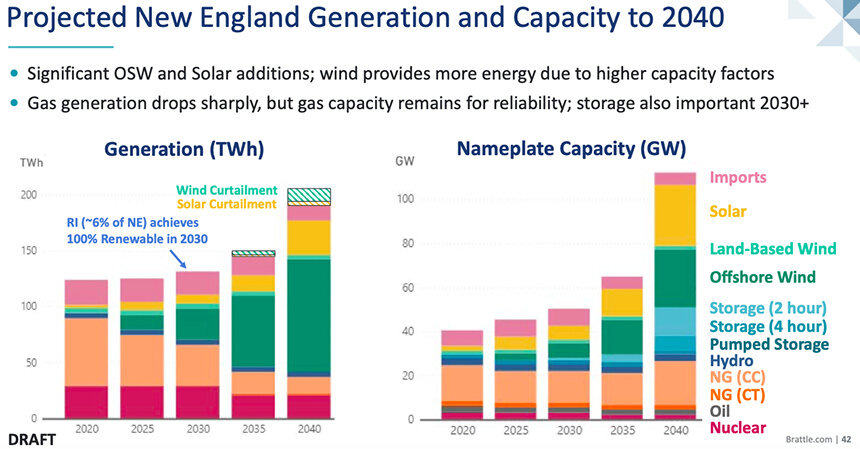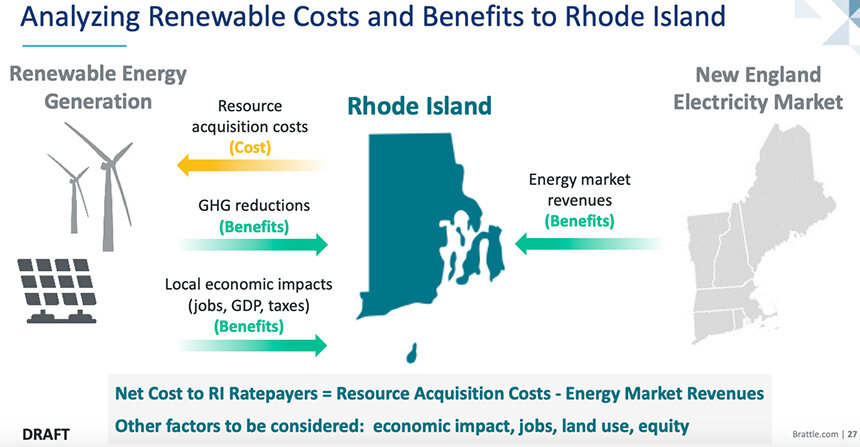Rhode Island has Options for 100% Renewable Energy By 2030
October 7, 2020
Rhode Island’s path to achieving 100 percent renewable energy by 2030 is becoming clearer. But there will likely be many unresolved issues once the plan is released by the end of the year.
The hope is that the proposal, put forth by The Brattle Group, will offer ways the state can buy renewable energy from wind facilities and solar arrays, either in Rhode Island or across New England.
The report is expected to include model portfolios, policy suggestions, and cost-benefit analyses. The second of three public webinars put numbers to the task ahead.

Rhode Island needs some 4,440 gigawatt-hours of renewable-energy generation to meet its predicted 7,700 gigawatt-hours of electricity use in 2030. That works out to securing about 440 gigawatt-hours of new renewable power annually for 10 years.

Another 400 gigawatt-hours of renewable power is needed each year from 2030 to 2050 to meet the state’s goal of reducing greenhouse gas emissions 80 percent by 2050. That includes having to replace wind turbines and solar systems that exceed service years.
One of the most likely recommendations for meeting 100 percent by 2030 is to increase the amount of renewable electricity National Grid buys and delivers to customers. That mandatory level of “green” power required for the Renewable Energy Standard (RES) is at 16 percent today. It increases to 38.5 percent by 2035.
“The Renewable Energy Standard creates the demand for renewable energy and this is the mechanism for tracking progress about whether you achieve [the goal] or not,” Mike Hagerty, a senior associate for The Brattle Group, said during the Sept. 29 webinar.
National Grid has resisted past increases to the RES, but Terry Sobolewski, president of National Grid Rhode Island, has said “we stand ready to work with stakeholders to make this next milestone a reality.”
The Brattle Group consultants see four main sources for acquiring renewable energy: offshore wind; onshore wind; utility-scale solar; and small-scale solar systems, referred to as distributed generation. Nuclear power isn’t considered because it’s unlikely a new facility can be approved and built by 2030. Large-scale hydropower from Canada was likewise omitted due to the difficulties in approving and installing transmission lines by 2030.

Brattle sees limited contribution from emerging forms of renewable power that won’t likely be generating a meaningful amount of electricity during the next 10 years. These sources include landfill gas, anaerobic digesters, biomass, small-scale hydropower, tidal hydropower, and fuel cells.
“We’re not evaluating them closely because we just don’t think that they’ll play as large a role as the other resources,“ Hagerty said.
The final report won’t devote much analysis to health benefits because all the models are expected to have similar health benefits. Although polluting fossil fuel power isn’t going away.

Rhode Island only generates about 6 percent of the electricity that goes into the New England power grid. And the Ocean State will need renewable power from other states to meet its 2030 goal, even while fossil-fuel plants endure.
“The impact of Rhode Island’s reduction in fossil demand spread across all of New England is likely to have a fairly modest affect on the in-state production of fossil energy,” Dean Murphy, principal at The Brattle Group, said.
Thus, switching to 100 percent renewable energy doesn’t mean Rhode Island’s power plants will stop operating and emitting greenhouse gases and other pollutants in 2030. As they will “still very likely be fossil generators within the state that are serving load for other states,” Murphy said. “They will be kept around, at least for a while to provide reliability to the system.”
Keeping fossil fuel power plants online alleviates intermittency, when solar and wind aren’t available, but the problem may get worse after 2030 when other states ramp up their renewable energy demand to achieve their 2050 emission reduction targets. At that point, there will be heightened demand for storage from batteries, fuel cells, and pumped-storage hydroelectricity, according to Brattle.
Environmental justice and equity benefits will likely be realized by simply cleaning up the power grid.
“We are cleaning up the Rhode Island electricity system so at least the trajectory ought to be to remove harm that might have been inflicted in the past,” said Jürgen Weiss, of The Brattle Group.
Frontline communities, he noted, can gain from policies that build renewable projects by creating jobs in their neighborhoods.

These and other benefits will be presented at the third public webinar, likely to be held in November, when Brattle will offer more precise renewable-energy portfolios for the state to consider for the 2030 goal. So far, offshore wind appears to be the least expensive, costing as little as $7 per megawatt-hour. Small-scale solar is the most expensive at $97 per megawatt-hour.
In addition to ratepayer impacts, the next phase of the report is expected to compare these costs with the economic benefits relating to jobs, gross domestic product, and income.

Questions were raised during the latest webinar about real-time struggles developers are experiencing with interconnection, siting, and transmission and distribution of building renewable-energy projects.
Weiss noted those issues go beyond the report — and state borders.
“It’s not in our scope in some ways to figure out what the optimal evolution is of the Rhode Island grid or the New England grid,” Weiss said. “Figuring that out by itself is really hard and then implementing that optimal grid expansion would be even harder.”
Murphy noted that, “Just staying at 100 percent [renewable energy] as the electric load grows over time with more electrification will itself be a challenge.”
Nick Ucci, commissioner of the Office of Energy Resources, noted that the renewable energy goal is connected to efforts to decarbonize heating, transportation, and housing.
“There are more variables than we can account for,” he said. “Technology is evolving; we will need flexibility to adjust on the fly to achieve our long-term energy and environmental goals. And that’s true for Rhode Island and it’s true for the rest of the states in the region.”




We are going to have to start using less power. And will as the resource crashes affect everything.
Thank you for posting this. Will there be more webinars on this topic? I looked through the article but didn’t see any info on future webinars.